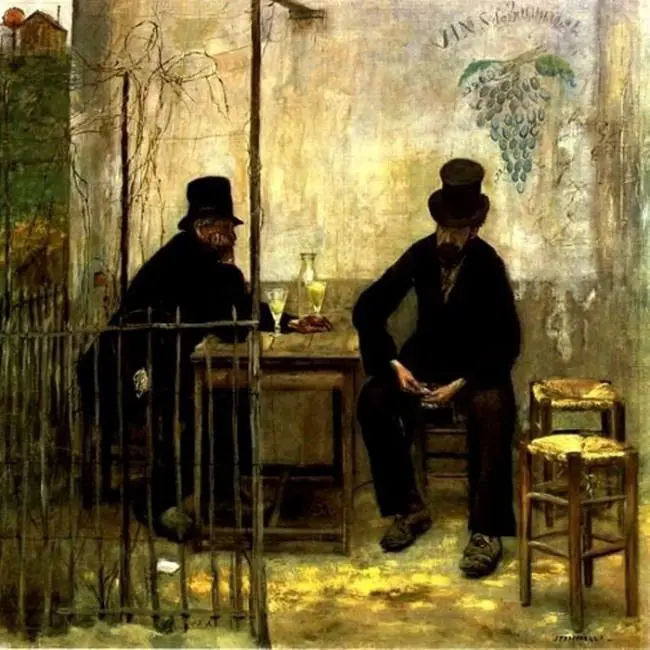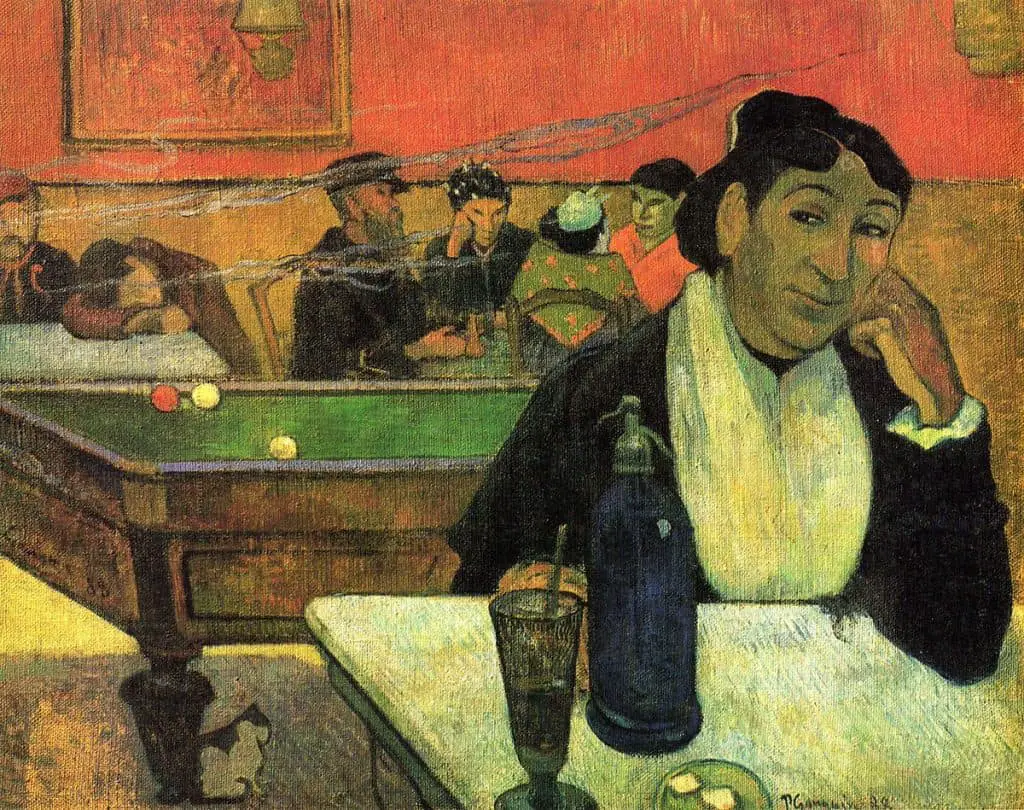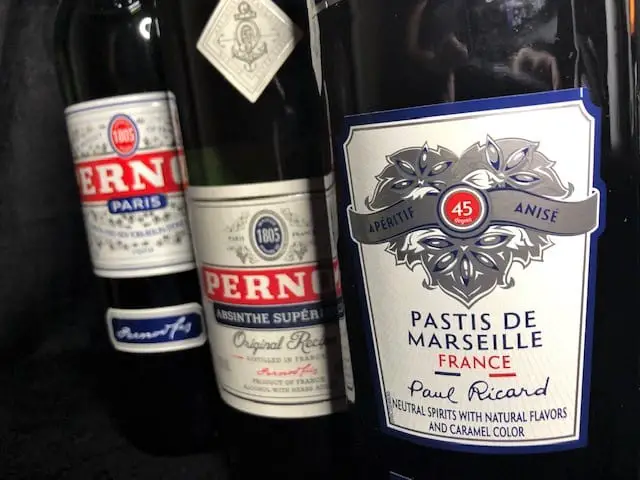Absinthe and Chartreuse are two unique and distinct spirits that are often compared due to their similar green color.
However, there are actually several key differences between the two that set them apart!
So, let’s take a closer look at these enchantingly green spirits. Specifically, we’ll look at the production of each as well as their unique histories and cultural origins.
Let’s dive in!
Origins and History
Both absinthe and Chartreuse have a rich history and unique origins.
Chartreuse is a French herbal liqueur that has been made by Carthusian monks since the 18th century. The liqueur is named after the Chartreuse Mountains in France, where the Carthusian monastery, La Grande Chartreuse, is located.
The recipe for Chartreuse is said to have been given to the Carthusian monks in 1605 and has been passed down through generations of monks ever since.
This “elixir of long life” recipe is still kept utmost secret (with only two monks at a time knowing the recipe), and sales of Chartreuse help finance the monastery’s operations to this day.
Absinthe, on the other hand, has a more… shall we say… controversial history.
It is a green anise-flavored spirit that was first produced in Switzerland in the late 18th century. Absinthe became popular in France in the 19th century and was often referred to as “the green fairy” due to its green color and alleged hallucinogenic effects.
However, absinthe was banned in many countries in the early 20th century due to concerns about its alleged toxicity.
While both absinthe and Chartreuse are made by following intricate and delicate production processes that result in a brilliantly green product, these two spirits are quite different.
Chartreuse is made by steeping a blend of herbs and spices in alcohol, while absinthe is made by distilling a mixture of herbs, including wormwood, anise, and fennel.
The wormwood used in absinthe is what gives it its distinctive bitter flavor and was infamously blamed for giving absinthe supposed hallucinogenic effects.
Related: Debunking Absinthe Myths
Despite its controversial past, absinthe has been making a comeback in recent years, and it is now legal in many countries.
On the other hand, Chartreuse remains a popular liqueur among cocktail enthusiasts and is available in green and yellow varieties.
However, limited production combined with increased demand has made Chartreuse much harder to acquire in recent years as the monks who make it have expressed environmental concerns related to increased production.
Not to mention, they also wish to refocus their attention on their prayers and monastic duties.
Can you blame them, though? They are monks, after all!

Production and Ingredients
Both absinthe and chartreuse are highly alcoholic concoctions that are made with a variety of herbs and botanicals. However, the herbs and botanicals used in each are quite different.
True absinthe is made with the “Holy Trinity” of grande wormwood, fennel, and anise (which gives it a distinct “licorice” flavor.) Other herbs and botanicals, such as hyssop, lemon balm, and coriander, are also commonly used in producing absinthe.
The grande wormwood used in absinthe contains thujone, a chemical compound that was once thought to be responsible for absinthe’s supposed hallucinogenic properties. However, modern absinthe contains very low levels of thujone and is not considered to be hallucinogenic.
Related: Absinthe Quality Red Flags To Watch For!
Chartreuse, on the other hand, is made with a blend of 130 herbs, plants, and flowers, including angelica, chamomile, hyssop, and thyme. The exact recipe for Chartreuse is a closely guarded secret that is known only to a select few monks who live in the Chartreuse Mountains of France.
Chartreuse comes in two varieties: green and yellow.
Green chartreuse gets its color from chlorophyll and is made with more aromatic herbs that give it a flavor profile that is both spicy and curiously mossy. Meanwhile, yellow chartreuse is milder and sweeter and is made with different botanicals.
Both absinthe and chartreuse have a high alcohol content, with absinthe typically ranging from 45-74% ABV and chartreuse at 55% ABV (or 40% ABV for the milder yellow variety).
After the herbs and botanicals are macerated in alcohol, the resulting mixture is distilled and then aged in oak casks for several years before being bottled.
Color and Appearance
Both Chartreuse and Absinthe have a distinct color that sets them apart and gives them a great deal of eye-catching “shelf appeal” in your local liquor store.
As previously mentioned, Chartreuse comes in two varieties: green and yellow.
The vibrant green color of green Chartreuse comes from the addition of chlorophyll, which is extracted from the herbs used in the recipe. Yellow Chartreuse, on the other hand, gets its signature hue from the saffron used to make it.
In fact, this color is so iconic that the color chartreuse was explicitly named after this liqueur!
Absinthe, on the other hand, does come in a variety of styles that have some effect on its color and appearance.
The standard absinthe verte typically comes in a shade of green that ranges from pale green to a brilliant peridot color. Much like with green Chartreuse, this color comes from the maceration of herbs such as wormwood, anise, and fennel.
Yet still, some absinthes are perfectly clear (these absinthes blanches skip the final maceration step) or even pink/red in the case of absinthes rouges, which include hibiscus flowers!
Of course, the color of absinthe can also vary depending on the method of production, as well as the age of the drink. Some absinthes may have a brown/amber hue due to natural aging.
(We don’t discuss the “absinthes” that are dyed an artificial neon green.)
So, while both Chartreuse and Absinthe have a greenish hue, the shades and vibrancy of the colors are different. Green Chartreuse is brighter and more vivid, whereas absinthe traditionally has a deeper and darker shade of green.
Taste and Flavor Profile
Both absinthe and chartreuse are known for their distinct taste and flavor profiles. The green hue of absinthe and chartreuse may be similar, but their flavors are worlds apart.
Absinthe is typically bitter and frequently has a strong alcohol taste, with a sweetness that comes from the addition of sugar when preparing it.
It also has a distinctive anise flavor that is often compared to black licorice. Many absinthe varieties also include pronounced notes of mint, coriander, and citrus (among other things).
On the other hand, Chartreuse has a sweet, spicy, and smooth flavor with a distinctly fresh and herbal finish.
But such a unique and complex taste that is hard to describe should surely be expected from a liqueur that is made with a secret blend of over 130 herbs, plants, and flowers!
Meanwhile, the sweetness in Chartreuse comes from the addition of honey and saffron.

Serving and Consumption
When it comes to serving and consumption, both absinthe and Chartreuse have their own unique rituals and methods.
Whether you prefer a traditional absinthe louche or a classic chartreuse cocktail, both of these spirits are sure to impress with their complex flavors and rich history.
Absinthe
Traditionally, absinthe is served in a small glass with a sugar cube, a spoon, and a carafe of ice water.
The spoon is slotted and placed on top of the glass, and the sugar cube is placed on top of the spoon. The ice water is then slowly dripped over the sugar cube, which gradually dissolves and drips sweet water into the absinthe below.
This causes the absinthe to turn cloudy and release its herbal flavors in a process known as the “louche.”
Learn More: Beginner-Friendly Guide to Preparing Absinthe The Right Way!
Chartreuse
Chartreuse is typically either served neat or in cocktails, particularly in many classic recipes.
When served neat, Chartreuse is usually sipped slowly from a small glass. It can be enjoyed chilled, at room temperature, or over ice as you prefer.
Despite its “fancy” nature, Chartreuse is a very adaptable and, in many ways, unpretentious liqueur that can be enjoyed in a multitude of ways!
Chartreuse can also be used as a base for cocktails, and its herbal flavors and bright green color make it a popular ingredient in many classic cocktails.
Popular cocktails that call for Chartreuse include the Last Word, Alaska, and Bijou.
In fact, many people also swear by combining hot chocolate and Chartreuse to make what’s called a Verte Chaud.

Cultural Significance
Absinthe and Chartreuse have both played significant roles in cultural history.
Absinthe, also known as the “Green Fairy,” was popular among bohemian artists and writers in the late 19th and early 20th centuries. It was often consumed in the traditional French ritual involving a slotted spoon, sugar cube, and water.
The drink was thought to inspire creativity and enhance artistic vision, although it was also (falsely) associated with dangerous and addictive behavior, including the infamous “Absinthe Murders.”
Chartreuse, on the other hand, is a French cordial that has been enjoyed by both royalty and commoners throughout its exceptionally long history.
While both Absinthe and Chartreuse have been associated with artists and writers, the cultural significance of each drink is quite different.
For example, absinthe was often seen as a symbol of rebellion and nonconformity, and in many ways still is.
Meanwhile, Chartreuse was historically a favorite of the upper classes and was often served at traditional or formal events. Famous admirers of Chartreuse include Queen Elizabeth II, Charles De Gaulle, and Tsar Nicholas II.
Of course, both absinthe and Chartreuse have experienced a huge resurgence in popularity in recent years.
This is especially the case after the 2020 lockdowns encouraged an entirely new generation of home mixologists to begin exploring new and curious spirits.
And let’s be honest, it’s hard to get more curious than absinthe and Chartreuse!

Is Chartreuse an Absinthe Alternative?
Before we wrap up, there’s a certain elephant in the room that we still need to address. Specifically, there is a ton of confusion about whether or not Chartreuse can be used instead of absinthe in cocktails.
I understand where this comes from, and let’s be honest, neither of these is exactly cheap.
If you can even find Chartreuse, you’ll be paying at least $60 for a 750ml bottle but possibly even as high as $100. Meanwhile, a decent absinthe will also be in that same $60-$80 price range.
That’s a lot of money to drop for a recipe like the Sazerac that just calls for a quick rinse!
Heck, maybe you really want a Corpse Reviver No 2 but find yourself with no absinthe and are eyeing that bottle of Chartreuse on your shelf.
For my two cents, I wouldn’t recommend substituting Chartreuse for absinthe or vice-versa.
While they are both green and herbal, the deep and complex flavors between the two are incredibly different.
If you do try to swap one out for the other, you’re going to have to do a lot of experimentation to make the final product taste right, as we discovered in my Fairy’s Last Word recipe!
If a drink calls for absinthe, but you need a substitute, you’d be much better served by using a good pastis or either Pernod or Herbsaint. Those are going to have more of the flavors that the recipe is trying to capture.
Related: Absinthe, Pernod, and Pastis: What’s the Difference?
Final Thoughts – Absinthe vs Chartreuse
I hope this article has helped you learn the differences between absinthe and Chartreuse.
With their storied histories, complex production processes, and herbal flavors, it’s not entirely inaccurate to consider these two drinks cousins. Each is undoubtedly its own thing, but there’s a certain mystique that seems to bind them.
Of course, if forced to choose between absinthe and Chartreuse, I’m always going to side with my beloved Green Fairy. But you can look at the name of this site and tell that I’m a bit biased!
That said, I also have quite a weak spot for Chartreuse and am glad that this centuries-old liqueur is finding new life. Even with the current slow-down in production, it’s a staple in my home bar that I try to keep on hand.
If you like complex herbal flavors with a hint of centuries-old monastic secrecy, it’s worth a try!

